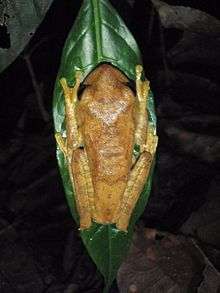Map tree frog
| Map tree frog | |
|---|---|
_in_Peru.jpg) | |
| Scientific classification | |
| Kingdom: | Animalia |
| Phylum: | Chordata |
| Class: | Amphibia |
| Order: | Anura |
| Family: | Hylidae |
| Genus: | Hypsiboas |
| Species: | H. geographicus |
| Binomial name | |
| Hypsiboas geographicus (Spix, 1824) | |
The map tree frog, Hypsiboas geographicus, is a species of frog in the Hylidae family found in Bolivia, Brazil, Colombia, Ecuador, French Guiana, Guyana,[1] Peru, Suriname, Trinidad and Tobago, and Venezuela. Its natural habitats are subtropical or tropical dry forests, subtropical or tropical moist lowland forests, moist savanna, subtropical or tropical seasonally wet or flooded lowland grassland, rivers, freshwater lakes, intermittent freshwater lakes, freshwater marshes, plantations, rural gardens, heavily degraded former forests, ponds, and aquaculture ponds. It was previously known as Hyla geographica. The name comes form the supposedly map-like patterns on its belly. The black tadpoles congregate in dense clusters in ponds or other calm waters.[2]

References
- ↑ Cole, C.J., C.R. Townsend, R.P. Reynolds, R.D. MacCulloch and A. Lathrop (2013). "Amphibians and reptiles of Guyana, South America: Illustrated keys, annotated species accounts, and a biogeographic synopsis". Proceedings of the Biological Society of Washington. 125: 317–620. doi:10.2988/0006-324x-125.4.317.
- ↑ Duellman, WE & J Lescure (1973). "Life history and ecology of the hylid frog Osteocephalus taurinus, with observations on larval behaviour". Occasional Papers of the Museum of Natural History, University of Kansas. 13: 1–12.
- Azevedo-Ramos, C., La Marca, E., Coloma, L.A., Ron, S. & Hardy, J. 2004. Hypsiboas geographicus. 2006 IUCN Red List of Threatened Species. Downloaded on 21 July 2007.
